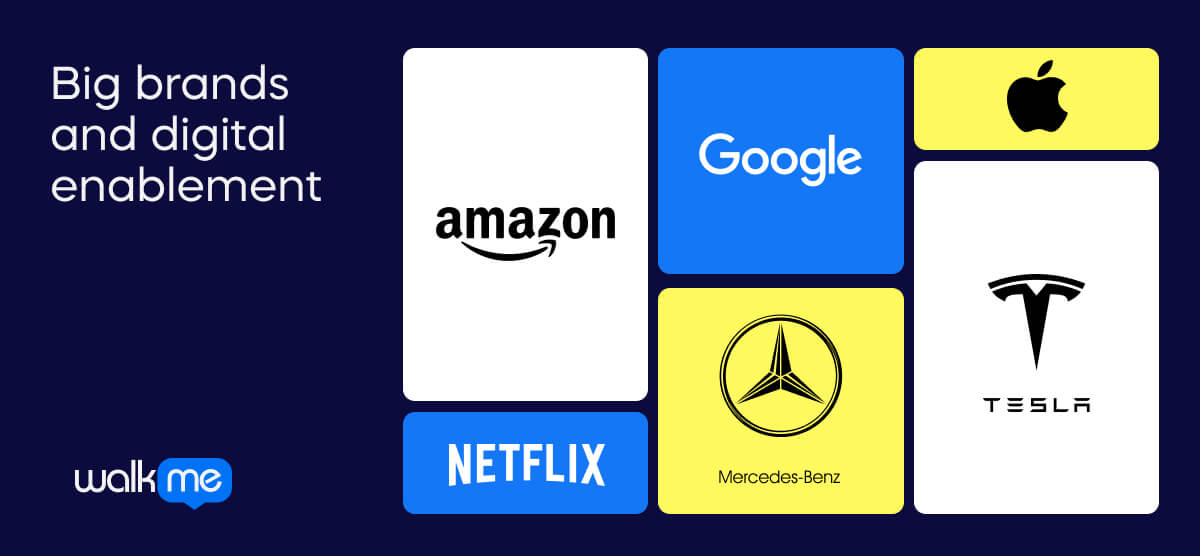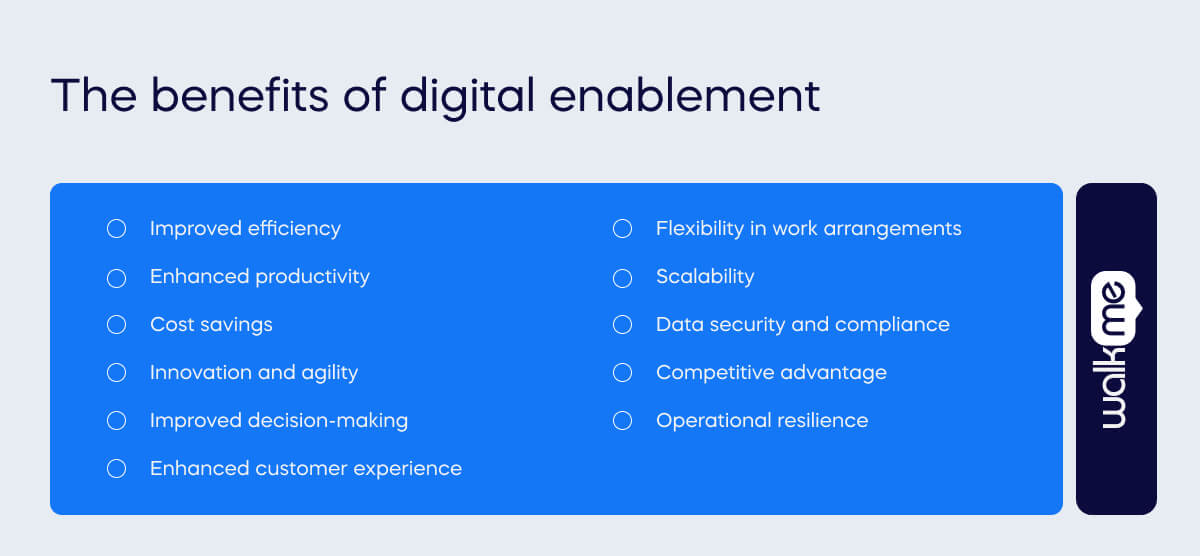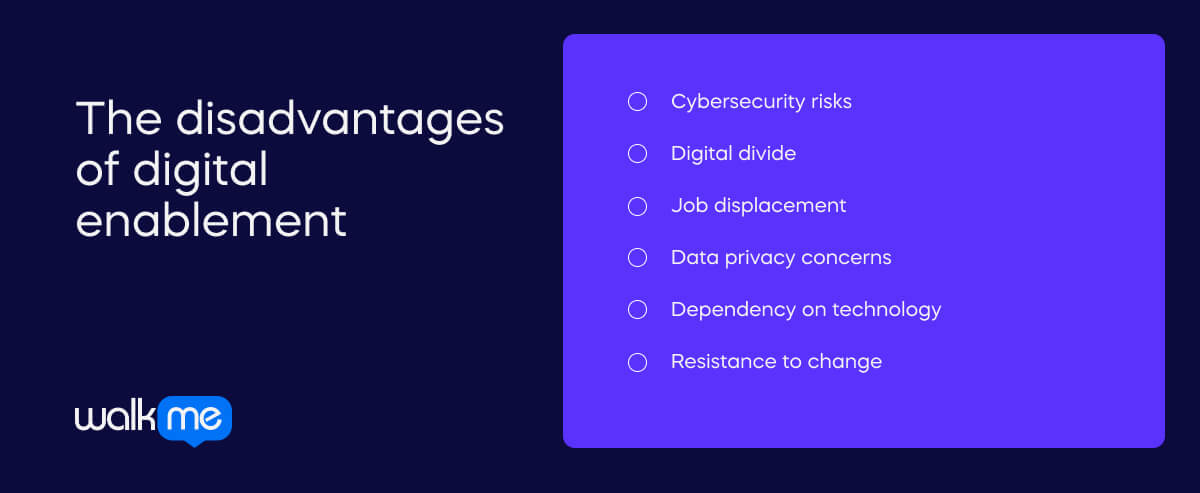What is digital enablement?
Digital enablement refers to leveraging digital technologies and tools to enhance and empower individuals, businesses, or organizations to achieve their goals more effectively.

Table of contents
- What is digital enablement?
- Aligning digital strategy with business objectives
- Examples of digital enablement
- How digital enablement assists with business objectives
- Big brands and digital enablement
- Digitalization vs. digital transformation vs. digital enablement
- What are the benefits of digital enablement?
- What are the disadvantages of digital enablement?
- Rolling out digital enablement
It involves integrating digital capabilities into various operations, processes, and strategies to improve overall efficiency, productivity, and outcomes.
Digital enablement is often seen as a means to drive innovation, competitiveness, and adaptability and should be a top priority for HR leaders.
Gartner reveals that ANZ organizations are “ investing in digital enablement, either to improve cost and operational efficiencies or to augment a traditional product set with digital capabilities so they can offer more services.”
Digital enablement is not just about adopting new technologies but also about fostering a culture of continuous improvement and embracing digital transformation as an ongoing process.
Aligning digital strategy with business objectives
Digital enablement aligns digital strategies with business objectives by integrating digital technologies and capabilities in a way that directly supports and enhances the achievement of organizational goals.
Here’s how digital enablement facilitates this alignment:
Identification of business objectives
The first step in aligning digital strategies is clearly defining and understanding the business objectives. These objectives include increasing revenue, improving customer satisfaction, enhancing business process transformation, expanding market share, or any other specific goals.
Mapping digital capabilities
Once business objectives are identified, organizations assess the digital capabilities required to achieve these objectives. This involves understanding which digital technologies, tools, and processes can contribute most effectively to the desired outcomes.
Integration of digital technologies
Digital enablement involves the strategic integration of digital technologies into various aspects of the business. This may include implementing cloud computing, data analytics, artificial intelligence, automation, and other technologies aligning with the objectives.
Customization for specific goals
Digital strategies are customized to address specific business objectives. For example, if the goal is to improve customer engagement, the digital strategy might focus on implementing customer relationship management (CRM) systems, personalized marketing, and social media engagement.
Data-driven decision-making
Digital enablement emphasizes the importance of data in decision-making. Organizations collect and analyze data to gain insights into customer behavior, market trends, and operational performance. This data-driven approach ensures that strategies are based on real-time information and feedback.
Agility and flexibility
Digital enablement promotes agility and flexibility in responding to changing business environments. Digital strategies are designed to be adaptable, allowing organizations to pivot quickly in response to market dynamics, emerging technologies, or shifts in customer preferences.
Enhanced customer experiences
Aligning digital strategies with business objectives often involves a focus on improving customer experiences. This could include the development of user-friendly interfaces, personalized interactions, and efficient customer service through digital channels.
Efficiency improvements
Digital enablement aims to enhance operational efficiency. Strategies include automating manual processes, the implementation of digital workflows, and using technologies that streamline internal operations, contributing to cost savings and resource optimization.
Measurement and performance metrics
Key performance indicators (KPIs) are established to measure the success of digital strategies in achieving business objectives. These metrics provide organizations with a quantitative means of assessing the impact of digital enablement on their overall performance.
Continuous improvement
Digital enablement is an ongoing process that involves continuous improvement. Organizations regularly assess the effectiveness of their digital strategies, make adjustments based on feedback and results, and seek opportunities for innovation and optimization.
Examples of digital enablement
Understanding examples of digital enablement is crucial as they illustrate practical applications of technology in enhancing business processes and customer experiences.
Real-world cases showcase the transformative power of digital tools, inspiring informed decision-making and strategic planning for organizations aiming to harness the benefits of digital innovation.
Here are some examples of digital enablement across various sectors:
E-commerce platforms
- Implementation of AI-powered chatbots to provide instant customer support.
- Personalized recommendation engines based on user behavior and preferences.
- Integration of secure online payment systems and digital wallets.
Healthcare
- Electronic Health Records (EHR) for centralized and easily accessible patient information.
- Telemedicine platforms for remote consultations and monitoring.
- Wearable devices and mobile apps for health tracking and preventive care.
Manufacturing
- IoT sensors on machinery for real-time monitoring and predictive maintenance.
- Digital twin technology for virtual simulation and optimization of manufacturing processes.
- Supply chain management software for enhanced visibility and efficiency.
Financial services
- Online banking and mobile apps for easy and secure financial transactions.
- Robotic process automation (RPA) for automating routine and rule-based tasks.
- Blockchain technology for secure and transparent transactions.
Education
- Learning Management Systems (LMS) for online course delivery and student management.
- Virtual classrooms and video conferencing tools for remote education.
- Adaptive learning platforms that customize educational content based on individual student progress.
Retail
- RFID technology for inventory management and supply chain optimization.
- Mobile point-of-sale (mPOS) systems for flexible and efficient checkouts.
- Augmented Reality (AR) for virtual try-on experiences and product visualization.
Human resources
Cloud-based HR management systems for employee data storage and access.
Applicant Tracking Systems (ATS) for streamlined recruitment processes.
Employee self-service portals for leave requests, performance reviews, and other HR-related tasks.
Smart cities
IoT sensors for real-time monitoring of traffic, waste management, and energy consumption.
Mobile apps allow citizens to report issues, access public services, and receive alerts.
How digital enablement assists with business objectives
Understanding how digital enablement helps with business objectives is crucial for informed decision-making.
It enables organizations to align technology initiatives with strategic goals, ensuring efficient resource allocation and maximizing the impact of digital tools on core business functions. This comprehension fosters adaptability, innovation, and sustained growth in a rapidly evolving business landscape.
Here are some examples:
Improve customer engagement and satisfaction
Digital enablement enhances customer engagement and satisfaction by providing personalized experiences, seamless interactions, and efficient problem resolution. It ensures a customer-centric approach, fostering loyalty and positive brand perception.
Solution: Implement a customer relationship management (CRM) system to track customer interactions, preferences, and feedback.
Result: Personalized marketing campaigns, targeted promotions, and efficient customer support contribute to increased customer satisfaction and loyalty.
Increase operational efficiency
Digital enablement boosts operational efficiency by automating processes, optimizing workflows, and facilitating real-time data access. This leads to streamlined operations, reduced costs, and faster decision-making, promoting organizational effectiveness.
Solution: Introduce robotic process automation (RPA) to automate routine and repetitive tasks, such as data entry and invoice processing.
Result: Streamlined operations, reduced manual errors, and improved efficiency in back-office processes, leading to cost savings and faster task completion.
Expand market reach and improve brand visibility
Digital enablement extends market reach and enhances brand visibility by leveraging online platforms, targeted marketing, and data analytics. It enables organizations to connect with a broader audience, drive brand awareness, and adapt strategies for optimal market impact.
Solution: Leverage digital marketing strategies, including social media campaigns, search engine optimization (SEO), and online advertising.
Result: Increased online visibility, broader reach to target audiences, and enhanced brand awareness, contributing to market expansion and customer acquisition.
Optimize supply chain management
Digital enablement optimizes supply chain management by providing real-time visibility, predictive analytics, and automation. This ensures efficient inventory management, reduces lead times, and enhances overall supply chain responsiveness, resulting in cost savings and improved operational resilience.
Solution: Utilize Internet of Things (IoT) sensors and data analytics to monitor and optimize the supply chain, from production to distribution.
Result: Improved visibility into inventory levels, reduced lead times, and enhanced supply chain responsiveness, leading to cost savings and better inventory management.
Enhance employee productivity and collaboration
Digital enablement elevates employee productivity and collaboration through tools like cloud-based platforms, communication apps, and collaborative software. It fosters seamless communication, facilitates remote work, and supports efficient teamwork, ultimately boosting overall productivity and employee satisfaction.
Solution: Set up collaboration tools, project management platforms, and employee training programs for digital skills development.
Result: Improved communication, collaboration, and knowledge sharing among employees, leading to increased productivity and a more engaged workforce.
Provide personalized customer experiences
Digital enablement contributes to personalized customer experiences by leveraging data analytics and AI. It enables businesses to tailor products, services, and interactions based on individual preferences, increasing customer satisfaction, loyalty, and a competitive edge in the market.
Solution: Data analytics and machine learning algorithms analyze customer behavior and preferences.
Result: Personalized product recommendations, targeted marketing messages, and customized user experiences, leading to increased customer satisfaction and loyalty.
Foster sustainability and environmental responsibility
Digital enablement promotes sustainability and environmental responsibility by enabling data-driven insights for resource optimization. Organizations can reduce waste, energy consumption, and carbon footprint through automation and analytics, fostering a commitment to eco-friendly practices and contributing to a more sustainable future.
Solution: Implement IoT devices and data analytics to monitor energy consumption, reduce waste, and optimize resource usage.
Result: Improved environmental sustainability, reduced carbon footprint, and operational cost savings through more efficient resource utilization.
Big brands and digital enablement

Numerous big brands across diverse industries are actively implementing innovative digital enablement strategies.
Embracing technologies such as AI, IoT, and data analytics, they enhance customer experiences, streamline operations, and boost overall efficiency. These forward-thinking initiatives underline the pivotal role of digital enablement in driving competitive advantage and sustainable growth.
Here are some examples from well-known global brands:
Amazon
Amazon has revolutionized retail by leveraging digital technologies such as personalized recommendations, one-click ordering, and streamlined supply chain management. Additionally, Amazon Web Services (AWS) offers cutting-edge cloud computing solutions. Through these innovations, Amazon continues to redefine customer experiences and set benchmarks for operational efficiency in the retail sector.
Google is a trailblazer in digital enablement, shaping industries with its search engine, online advertising platforms, and productivity tools like the Google Workspace suite. The company’s commitment to data-driven decision-making and constant innovation has set industry standards and defined the evolving landscape of digital excellence.
Apple
Apple stands out in digital enablement, curating a seamless ecosystem of products and services encompassing the iPhone, iPad, Mac, and services like the App Store, iCloud, and Apple Music. The unparalleled user experience stems from Apple’s commitment to seamless integration, solidifying its position as a leader in digital innovation and customer satisfaction.
Tesla
Tesla’s impact on the automotive sector is profound, integrating digital technologies into electric vehicles. With over-the-air software updates, Tesla redefines the consumer experience, allowing continuous enhancements and new features without traditional service center visits. This approach marks a paradigm shift, showcasing Tesla’s commitment to innovation and convenience in the automotive realm.
Netflix
Netflix revolutionizes the entertainment landscape through its digital streaming platform. By harnessing the power of data analytics, it delivers personalized content recommendations, tailoring user experiences. The platform’s commitment to original programming, crafted from deep insights into user preferences, exemplifies its pioneering role in reshaping the future of on-demand content consumption.
Mercedes-Benz
McKinsey writes about how the company leveraged generative AI to bring a ChatGPT voice assistant experiment to 900,000 beta testers across North America.
CEO Philipp Skogstad said: “I think AI is a key enabler. A transformation is underway, and I think we all like to drive change. People want to drive change but don’t want to be changed. So the key here is to let people drive this transformation and to give them access to generative AI so they can play with it themselves.”
Digitalization vs. digital transformation vs. digital enablement
Digitalization, digital transformation, and digital enablement are related concepts but have distinct meanings.
Here’s a breakdown of each term:
| Digitalization | Digital transformation | Digital enablement |
| The process of converting information and processes into a digital format. | Involves the integration of digital technologies into all aspects of a business, fundamentally changing how the company operates and delivers value. | Focuses on empowering individuals, organizations, or processes through the strategic use of digital technologies. |
| Involves using digital technologies to transform analog or manual processes into digital ones. | Involves reimagining business models, customer experiences, and organizational culture to harness the full potential of digital technologies. | Involves providing the tools, skills, and capabilities needed to leverage digital resources effectively. |
What are the benefits of digital enablement?

Digital enablement offers numerous benefits to individuals, organizations, and processes.
Here are some key advantages:
Improved efficiency
Automation of routine tasks, streamlined workflows, and faster access to information contribute to increased operational efficiency.
Enhanced productivity
Digital tools and technologies enable employees to accomplish tasks more quickly and collaborate seamlessly, leading to higher productivity levels.
Cost savings
Automation, cloud computing, and digital workflows can reduce operational costs, minimize manual errors, and optimize resource utilization.
Innovation and agility
Digital enablement fosters a culture of innovation, allowing organizations to adapt quickly to changing market conditions and technological advancements.
Improved decision-making
Access to real-time data and analytics empowers decision-makers with valuable insights, supporting informed and data-driven decision-making.
Enhanced customer experience
Personalized interactions, efficient customer support through digital channels, and seamless online experiences contribute to improved customer satisfaction and loyalty.
Flexibility in work arrangements
Remote work options supported by digital tools provide flexibility, improving work-life balance and increasing employee satisfaction.
Scalability
Cloud-based solutions allow organizations to scale their operations easily, adapting to growing or changing business requirements.
Data security and compliance
Implementing robust cybersecurity measures ensures data security, protects sensitive information, and compliance with regulatory requirements.
Competitive advantage
Organizations strategically leveraging digital technologies often gain a competitive edge by being more innovative, responsive, and efficient than their counterparts.
Operational resilience
Digital enablement enhances operational resilience by enabling organizations to quickly adapt to disruptions, whether they be technological, economic, or environmental.
What are the disadvantages of digital enablement?

While digital enablement brings about numerous benefits, it is essential to recognize and address potential downsides and challenges associated with its implementation.
Some of the downsides include:
Cybersecurity risks
Increased reliance on digital technologies may expose organizations to cybersecurity threats like data breaches, hacking, and malware attacks.
Robust cybersecurity measures, regular security audits, and employee training on cybersecurity best practices are essential to mitigate risks.
Digital divide
Not all individuals or communities may have equal access to digital technologies, leading to a digital divide where some are left behind.
Inclusion and accessibility initiatives, digital literacy programs, and efforts to bridge the digital divide can help mitigate this challenge.
Job displacement
Automation and digital technologies may lead to the displacement of certain jobs, especially those that involve routine and repetitive tasks.
Upskilling and reskilling programs and focusing on creating new roles that leverage digital technologies can help address job displacement.
Data privacy concerns
Increased collection and use of personal data may raise concerns about privacy, leading to potential legal and ethical issues.
Strict adherence to data protection regulations, transparent data practices, and clear communication with users about data usage can help address privacy concerns.
Dependency on technology
Over-reliance on digital technologies may result in disruptions if there are technical issues, system failures, or cybersecurity incidents.
Implementing redundancy measures, disaster recovery plans, and regular system maintenance can reduce the impact of technology dependencies.
Resistance to change
Employees may resist changes associated with digital enablement, leading to challenges in adoption and implementation.
Comprehensive change management strategies, communication plans, and employee training programs can help manage resistance and foster a positive attitude toward digital transformation.
Rolling out digital enablement
Rolling out digital enablement in the workplace requires careful planning, communication, and a phased approach to ensure successful adoption.
Here’s a step-by-step guide to help you navigate the process:
Define clear objectives
Clearly articulate the goals and objectives of the digital enablement initiative. Understand how it aligns with broader business strategies and what outcomes you aim to achieve.
Conduct a digital readiness assessment
Assess the current state of digital readiness within the organization. Identify existing strengths, weaknesses, and areas that require improvement to effectively introduce digital enablement.
Create a cross-functional team
Assemble a diverse team representing different departments and stakeholders to understand needs and perspectives.
Develop a digital enablement strategy
Outline a comprehensive strategy that includes technology selection, employee training programs, change management initiatives, and a timeline for implementation.
Prioritize initiatives
Prioritize digital initiatives based on their impact on business objectives, ease of implementation, and potential for quick wins. This can help build momentum and demonstrate the value of digital enablement.
Invest in employee training
Provide training programs to equip employees with the digital skills to use new tools and technologies. Offer ongoing support to address any challenges they may encounter during the transition.
Establish clear communication channels
Develop a robust communication plan to keep employees informed throughout the process. Regularly update them on the status of the digital enablement initiative, milestones achieved, and any upcoming changes.
Implement pilot programs
Start with a pilot program in a specific department or team to test digital enablement initiatives on a smaller scale. Gather feedback, address issues, and refine the strategy based on the pilot’s outcomes.
Encourage feedback and collaboration
Foster a culture of open communication and collaboration. Encourage employees to provide feedback, share their experiences, and contribute to improving digital enablement processes.
Monitor and measure progress
Implement key performance indicators (KPIs) to track the success of digital enablement initiatives. Regularly assess progress, adjust strategies as needed, and celebrate achievements.
Scale gradually
Once the pilot program is successful, scale the digital enablement initiatives across other departments or teams. Use insights gained from the pilot to inform the rollout on a broader scale.